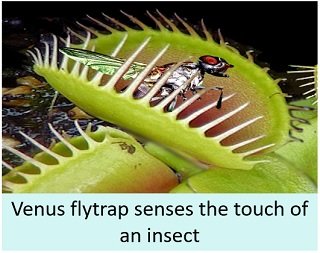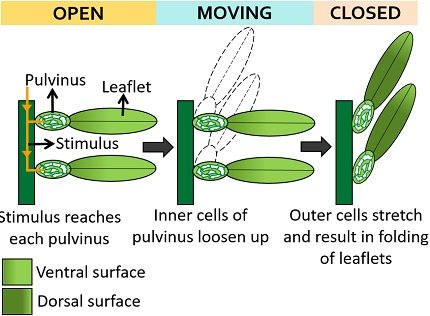Nastic movement is another form of curvature movement shown by some members of plants. It occurs in response to diffuse external stimuli. A stimulus that does not affect the plant’s orientation is called a diffuse stimulus. The direction of response in the nastic movement is independent of stimuli direction.
Nastic movement is also referred to as “Nasties”. External stimuli like light and touch are the significant factors responsible for nastic activity. Thus, plants show nasties in response to external stimuli but not towards the direction of the stimulus.
Therefore, it is a non-directional movement. Nastic movement may or may not show growth movement. This post mainly discusses the definition, key points, mechanism and types of nastic movement with examples and diagrams.
Content: Nastic Movement in Plants
Definition of Nastic Movement
It refers to the reversible movement in a plant caused due to the elastic changes in the size of special motor cells within the plant’s tissue. It is another type through which higher plants show curvature movement due to cell size and turgor pressure variations. The plant’s response to the external stimulus is generally non-directional. Alternations in the turgor pressure facilitate nastic movements like the opening and folding of leaves and petals in response to external stimuli.
Mechanism of Nastic Movement
Turgor pressure also determines the rigidity of plant cells, depending upon the cell’s water content. Therefore, a cell can be turgid or flaccid, depending upon the solute and solvent concentration inside and outside the cell.
Special motor cells, i.e. extensor and flexor cells within the pulvinus, contract and relax through the processes like exosmosis and endosmosis. Exosmosis makes the cell flaccid and causes the folding or closure of leaves. Oppositely, endosmosis makes the cell turgid and causes the straightening of leaflets.
Extensor cells experience high turgor during the leaflet opening and low turgor during the closure of leaflets. Unlike extensor cells, flexor cells go through reverse changes. The orientation of extensor and flexor cells may lie in the leaf’s abaxial or adaxial surface, depending on the type of plant.

Closure of leaves or petals occurs when water, potassium and chloride ions exit the cell due to the contraction of extensor cells or expansion of flexor cells. Oppositely, the opening of leaves or petals occurs when potassium and chloride ions accompanied by water enter the cell due to the expansion of extensor cells or the contraction of flexor cells.
Pinnules or leaflets open in the case of turgid ventral cells and flaccid dorsal cells. Pinnules or leaflets fold inwards in the case of less turgid ventral cells and more turgid dorsal cells.
Key Points
- Nastic movement in plants mainly occurs in response to external stimuli. However, plants may also show nastism in response to internal growth stimuli.
- “Turgor movement” and “Nasties” are the alternative terms of nastic movement.
- Light and contact are the typical external stimuli to which certain plants show nasties. In contrast, a plant’s growth and movement response to internal hormones and enzyme systems serve as internal growth stimuli.
- The development of bud to its opening and finally to its shedding shows autonomic or internally directed nastic movement.
- Closure and opening of leaves and petals in response to the changes in external stimuli like light, temperature, contact etc., shows paratonic or externally directed nastic movement.
- Unlike tropical movement, nastic activity in plants elicits a uniform response, thereby affecting the whole plant organ.
- Nastic movements are relatively faster than tropic movements.
- Photonastic, nictynastic and thermonastic are three types of plant’s movement that respond to the light stimulus.
- Haptonastic and Seismonastic are the two types of nastic movements that respond to mechanical stimuli like contact, heavy wind etc.
- The plant’s flat structures, like leaves and petals, mainly undergo nastic movement.
Types of Nastic Movement
Depending on the stimuli, turgor and growth movements are common nasties seen in some plants. Plants undergo turgor movement through changes in the turgor pressure and cell’s size. Photonasty, thermonasty, nyctinasty, seismonasty and haptonasty are the turgor movements. In contrast, plants also show nastic growth movements like hyponasty, epinasty and circumnutation.
Turgor Movements
We could demonstrate the pattern of turgor movements by taking examples of each type.
Photonasty: Alternations in the light stimulus induces this kind of movement in plants. Flowers and leaves exhibit photonasty through their cell’s opening and closing action. Leaves of Mimosa pudica remain straight during the daytime and begin to bend from the evening.

Thermonasty: Temperature variation induces such movement in plants. Here, flowers and leaves tend to open or close in response to a rise or drop in the temperature. Opening of Mirabilis jalapa is an example of thermonastic movement that starts blooming late afternoon or evening in response to a temperature drop and closes by mid-morning. The blooming of tulip flowers as the temperature rises is another example of thermonastic movement.

Nyctinasty: Alternations of the day and night temperature induce nyctinasty or sleeping movement in plants. Clover leaves remain straight during the day and begin to bend in the evening.

Seismonasty: Physical contact and mechanical disturbances like shaking, raindrops etc., is responsible for such movement in plants. Stigmas, stamens and leaves undergo seismonasty. Folding of Mimosa pudica leaves in response to touch.

Haptonasty: Tactile stimulus or sense of touch is responsible for such movement in some carnivorous plants such as Venus flytrap that respond instantly to the touch of any insect that may serve as a meal for that plant.

Nastic Growth Movements
Epinasty, hyponasty and circumnutation are the major growth movements that plants generally show.
Epinasty refers to the downward-bending of petals from growth at the top, for example, the opening of buds. Hyponasty is just the reverse of hyponasty, in which upward growth occurs from the bottom to the top. Here, the bud stays closed. Leaves and petals generally exhibit epinasty and hyponasty movements. Growing stems usually show circumnutation, in which stems produce helical coiling around suitable solid surfaces.

Conclusion
Plants show specific movements that can be either growth or non-growth movement and direction or non-directional movement. Nastic movement generally shows non-directional movements like turgor and nastic growth movements.
Higher plants exhibit movement of curvature that is categorized into two forms, tropism and nastism. Tropism in plants is a directional growth, whereas nastism is a phenomenon independent of the direction of external stimuli.
